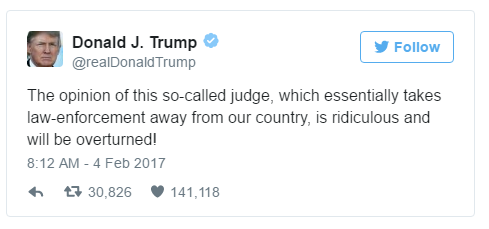News You Can Use: 2/8/2017

- Think employers must protect workers’ personal info? Think again
For example, the workers in the Pennsylvania case turned over their personal information as a condition of employment, not for safekeeping, according to the court decision. Using reasoning employed in a case brought by account holders against their bank, the judges decided the safety of the information wasn’t guaranteed.
Referencing another old case, the court said UPMC isn’t obliged to pay up if the stolen data resulted in purely economic losses but not damages to health, safety or property. That ruling drew on a decision where workers at a tire store sued for lost wages when the business shut down for a week when the property was flooded.
- Time for procurement to become entreprocurial
So what does Entreprocurial behaviour look like in practice?
- It is the CPO who convinces the executive board that building new factories to service a new and competitive market is high risk, but that the supplier network is reliable enough to contract manufacture and distribute the products, and so it is a risk worth taking.
- It is the procurement manager who not only secures a great innovation idea from an external party, but also takes personal ownership to turn that into an actual product.
- It is the CPO who shifts the focus from the supply market to a focus on adding value to the customer.
- How Journalism Was Corrupted by the Power of Privilege
Journalism is a topic I care about deeply and will cover frequently on this blog. Getting facts to people in the best possible method is good for any career. That said, Gary was a bit heavy handed in his point, but the outsider view has value. - Why Silicon Valley is high-fiving over Trump’s SEC pick
Perhaps more notably, says Tusk, Clayton “isn’t a policy activist. I don’t think this is someone with an ideological view about how security regulation should be expanded.”
That’s in stark contrast to Mary Jo White, a former litigator who stepped down as the head of the SEC at the end of the Obama administration. White had visited Silicon Valley nearly a year ago and put investors and founders on notice that the SEC was becoming concerned by spiking valuations in the private sector, among other things. As we wrote back in October, the SEC seemed to be using an investigation into troubled Theranos specifically to expand its mandate into Silicon Valley’s startup ecosystem.
https://techcrunch.com/2017/01/26/why-silicon-valley-is-high-fiving-over-trumps-sec-pick/?ncid=rss
- How to create your own opportunities at work
While it can be scary to work on a project with no obvious stakeholders, if it’s a truly valuable undertaking, it’ll prove itself. Other people will see its value as it develops, and you yourself will become more certain of it.
Keep in mind, however, that it’s essential that you believe in the value of the undertaking. If you’re not sure it’s worth pursuing, get a second opinion from someone you trust (a close colleague, a mentor), or table it until you find another opportunity that makes your heart beat faster with conviction.
Photo: Javier Garcia
The impact of H-1B modification on tech companies
Note: This blog is apolitical and I will do my best to keep this post free of spin and stick to the facts.
During my research for last week’s supplier report, it was clear that President Trump’s immigration policies were a major pain point for IT companies. It was such a reoccurring thread that I felt I needed to go deeper to better understand the situation.
On January 27th, 2017 Donald J. Trump released an executive order that modified travel rights into the United States from several countries.
The executive order imposed a 90-day travel ban on the citizens of seven predominately Muslim countries: Iraq, Syria, Iran, Sudan, Libya, Somalia and Yemen. It also suspends the U.S. Refugee Admissions Program for 120 days. Additionally, it indefinitely prohibits Syrian refugees from entering the U.S.
As of February 5th, the Department of Justice is blocking the President’s executive order:
The US Justice Department filed an appeal just after midnight Sunday, asking to pause a sweeping decision from the judge that temporarily halted enforcement of several key provisions of President Trump’s executive order.
The status of the executive order has fluctuated during last week, and it is clear that President Trump is planning to fight this most recent setback:

Trump’s modification of immigration policy has many in the technology industry concerned that the order was just the first step of more sweeping immigration reforms. It is being reported that the Trump administration is also drafting modifications to the H-1B visa program.
The US H-1B visa is a non-immigrant visa that allows US companies to employ graduate level workers in specialty occupations that require theoretical or technical expertise in specialized fields such as in IT, finance, accounting, architecture, engineering, mathematics, science, medicine, etc.
The program allows for 65,000 (+20,000 additional IT workers) into the country annually. Depending on the country, a worker can stay in the United States for 3 years with an option for an additional 3 year renewal.
Although there are annual controls on who is accepted into the via program, there doesn’t seem to be precise records on how many people in total are currently working in the U.S. under the H-1B visa program. It is estimated to be between 650,000-850,000.
White House press secretary Sean Spicer said the possible executive order on work visas “is part of a larger immigration effort” and stems from “an overall need to look at all of these measures.” C-level executives from many of the large technology firms have denounced this activity:
Microsoft CEO Satya Nadella:
“There is no place for bias or bigotry in any society, in any context. That’s where we start from,” Nadella told employees. “It is the enlightened immigration policy of this country that even made it possible for me to come here in the first place, and gave me all this opportunity.”
Google Co-Founder Sergey Brin:
“I think it’s important to not frame this debate as being ‘liberal’ versus ‘Republican’ and so forth,” Brin told the crowd. “It’s a debate about fundamental values, about thoughtful policymaking and many of the other things that I think are — apparently not universally adored — but I think the vast majority of our country and of our legislators and so forth support.”
Apple CEO Tim Cook sent an email to employees (and has not yet publicly commented):
There are employees at Apple who are directly affected by yesterday’s immigration order. Our HR, Legal and Security teams are in contact with them, and Apple will do everything we can to support them. We’re providing resources on AppleWeb for anyone with questions or concerns about immigration policies. And we have reached out to the White House to explain the negative effect on our coworkers and our company.
As I’ve said many times, diversity makes our team stronger. And if there’s one thing I know about the people at Apple, it’s the depth of our empathy and support for one another. It’s as important now as it’s ever been, and it will not weaken one bit. I know I can count on all of you to make sure everyone at Apple feels welcome, respected and valued.
Perhaps the Trump administration’s investigation and overhaul of the H-1B program is due to accusations of companies abusing the program. For example, Disney has been accused of laying off qualified domestic workers in favor of cheaper H-1B workers coming from India.
While the argument is being made that American interests are being protected by these measures, there is concern that by increasing the wage requirements for H-1B workers and making it more difficult to get these resources, US companies will just shift the job entirely to cheaper labor markets like India:
India’s technology companies, led by Tata Consultancy Services Ltd, Infosys and Wipro, have argued they are helping corporations become more competitive by handling their technology operations with specialized staff. They also contend the visa programs allow them to keep jobs in the U.S. and that if they have to pay more for staff, they will handle more of the work remotely from less expensive markets like India.
This is (clearly) a complicated issue that only gets more complex through a political filter. It seems possible that the H-1B program has been abused in the past and it is alarming that there isn’t precise documentation on how many people are working under the program currently.
The United States is a country that was forged through immigration and there are many examples of people coming here with nothing and creating companies and jobs. Turning away from that cultural identity can be damaging and have long lasting impact.
Photo: Ferdinand Stöhr
News You Can Use: 12/28/2016

- CEOs still don’t ‘get’ what their procurement teams do
“While a stagnant economy proved a fertile breeding ground for successful cost reduction strategies, the function needs to adapt to the new environment and demonstrate its versatility if it is to always be seated at the board table. For example, highlight how the department’s risk management programmes minimise the potential impact that a disaster could have on the business bottom line or the added value it can bring to the company’s corporate social responsibility programme and show how procurement is driving innovation within the supply chain, giving the company that competitive edge.”
- Open source and the software supply chain
You have two basic choices: either build your own internal means of vetting the code and applying product management processes, or rely on an intermediary to perform that function. You can make an argument for creating the processes for pulling down source code, determining legal compliance, applying patches, and getting it ready for production yourself, but it is expensive from a human resources point of view. You should base your decision whether or not to self-direct the process on its strategic importance to the company and some ROI analysis: If you build a team to manage that process for some software components, will you see a sufficient return on that investment?
https://opensource.com/article/16/12/open-source-software-supply-chain
- Kartik Gada: “The ATOM: The New Economics of Technical Disruption”
Kartik Gada joined Google to talk about his e-book the ATOM. The book examines the new economics of technological disruption, and its impact on governments, businesses, and society. The Atom is a 14-chapter e-book that contains novel concepts, research, and policy
- Follow-up to last week: Trump to tech CEOs: We’re there for you
“We want you to keep going with the incredible innovation,” Trump said. “There’s nobody like you in the world, in the world, there’s nobody like anyone in this room. And anything we can do to help this go along, and we’re going to be there for you.”
Among the issues the tech CEOs might discuss with Trump is his proposed curbs to immigration. Silicon Valley relies on bringing in large numbers of immigrants every year or keeping them in the U.S. after college. Making immigration more difficult or restricting the number of H-1B high-skill visas available could cause tech companies problems.
http://www.cio.com/article/3150604/regulation/trump-to-tech-ceos-were-there-for-you.html
- Procurement: Four opportunities ahead in 2017
In 2017 we will see supplier relationship management (SRM) come of age. Sitting in a unique position between the supply base and the business, procurement has a real opportunity to leverage that position to bring new innovations into the business. Capitalizing on their supplier management role, we will see more procurement teams using insight and market intelligence to seek out new suppliers and different ways of working to leapfrog endless iterations of ‘business as usual’ to really drive change. Moving away from reacting to the business or finding a cheaper way of working, the more challenging business environment will see procurement teams looking externally for innovative suppliers that can revolutionize the existing business and make a significant impact on the bottom line.
http://www.procurementleaders.com/blog/my-blog–guest-blog/four-opportunities-ahead-in-2017-657764
News You Can Use: 12/21/2016

- Why Trump and the Tech Industry Are on a Collision Course
During the campaign, Trump in turn lashed Apple for manufacturing too many of its products overseas. Stephen Bannon, the former chief executive of Breitbart—who has emerged as the ideological synthesizer of Trump’s worldview—has touted Democrats’ courtship of the technology industry as evidence the party had abandoned heartland workers for coastal elites. As Bannon recently told The Hollywood Reporter, “They were talking to these people with companies with a $9 billion market cap employing nine people. It’s not reality. They lost sight of what the world is about.”
- What Does It Mean to be “Strategic” in Supply Chain, Anyway?
A study in Supply Chain Quarterly provides six models or “styles” of Supply Chain strategy, each suited to a different kind of industry: “efficient” Supply Chains, “fast” Supply Chains, “continuous-flow” Supply Chains, “agile” Supply Chains, “custom-configured” Supply Chains, and “flexible” Supply Chains. These names might seem like different terms for the same thing – and these words often get thrown around as buzzwords all over the industry. But the study’s author, Hernan David Perez, goes into deep detail about the differences in each strategic approach that shows the depth and complexity inherent in developing a truly strategic Supply Chain.
https://blog.kinaxis.com/2016/12/mean-strategic-supply-chain-anyway/
- Tech industry sees new talent pool in people with autism
This isn’t new (but it is good)… SAP has been recruiting people on the spectrum for the last 4 or 5 years.There’s no job interview, and differences in ability are taken into consideration during the application process. Once on the job, specialist staff help support the participants.
http://www.sbs.com.au/news/article/2016/12/09/tech-industry-sees-new-talent-pool-people-autism

- Words Of Advice From Millennials In Supply Chain Management
Khan explains how she appreciates management that challenges her and suggests that employers need to recognize that not all millennials are the same – despite what the stereotypes might imply. The solution: get to know your millennial talent individually and take the time to understand their goals to help them reach their full potential. As the most educated generation, millennials are eager to apply their degrees in their work and they are driven to advance. However, that drive doesn’t necessarily mean they are willing to “job-hop”. Employers should strive to challenge millennials by rewarding performance with new responsibilities and opportunities to grow.
http://www.strategicsourceror.com/2016/12/words-of-advice-from-millennials-in_8.html
- To fix federal procurement, dump the DUNS number
But one outdated technology still stands in the way of transparency: the DUNS Number.
Twenty years ago, the federal government entered into an agreement with Dun & Bradstreet, Inc., to provide a numbering system to track contractors. In order to do business with the government, companies must pay Dun & Bradstreet to be issued a DUNS Number.
Dun & Bradstreet continues to own every DUNS Number. That means anyone who wants to download or analyze the government’s public procurement data must buy a D&B license.
Photo: Jonatan Pie



